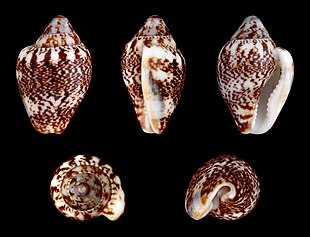Sea snail
As sea snails that are families and species of snails which have in the sea life. Due to the salty water, they sometimes have a different biochemistry from freshwater and land snails .
history
Fossil snails have been known since the early Cambrian approx. 530 million years ago, although the very oldest finds have not finally clarified whether they really belong to the class of snails. These first species lived in the sea on algae, possibly also on sponges. In ancient times , species of the genus Bellerophon were common. True freshwater and land lung snails are only known from the Mesozoic ( Jurassic Period ), but snails may well have lived on the mainland or in freshwater in earlier earth periods ( Triassic , late Paleozoic ).
Since the class of snails comes from the sea, the marine snails do not form a closed systematic group. The first gastropods were similar to today's limpets , mermaids worm , hole snails and abalone , which outwardly as mussels look like. These species then have a reduced expression of the right-left symmetry that is otherwise found in snails . A great diversity of species has developed over time. There are harmless grazers and poisonous predators. Many snails form massive shells to protect themselves. The nudibranchs and sea hares do without a shell and protect themselves by camouflage or with nettle cells that they ingest with their food and store in frayed body appendages. There are approximately 40,000 different marine gastropods, and freshwater and land taxa branch off at various points in the family tree .
Marine habitats
In the sea, snails colonize all areas from the surf zone to the deep sea , from the poles to the equator. They can be found in coral reefs , on sponges , in the sandy bottom, on rocks and perches and floating freely in the sea. There are the most unusual ways of life. The violet snail lives under a self-made raft made of mucous bubbles. It drifts across the sea and eats jellyfish when it meets them. Snails even live on black smokers . The best known is the "Scaly Snail" with its ferrous body scales. No less notable are worm snails . They grow together with the coral reef and feed by catching plankton with a slime net from the water. Cone snails hunt fish with poison arrows. Even more simple representatives like limpets, as territorial pasturelanders, display interesting behaviors.
Construction and shape of the shell
The housings are formed starting from the edge of the jacket and often have strong colors and sometimes a pearlescent finish on the inside . The color has little or no function because it is barely noticeable below 10 to 20 meters water depth . Here the red light has already been largely filtered out of the solar radiation , so that blue components predominate in the light. In addition, the colors of the shells are mostly caused by the dumping of waste products from protein metabolism .
The shells of sea snails are used in various cultures to make snail trumpets . Due to the special acoustic properties, the superstition is cultivated - mostly jokingly - that the sound of the sea is trapped in the snail shell and can be taken home as a preserved holiday memory. Some snails are also part of the zooplankton , such as Glaucus atlanticus or the predatory Pterotracheidae .
Well-known examples of sea snails
Many of the sea snails are popular as " seafood " and some are culinary delicacies, which is already a serious threat to the existence of some species.
In addition to abalones, which are very popular for Asian cuisine , this concerns z. B. the purple snails - but because of the production of the purple , which has been popular since ancient times .
Among the many, also smaller species - which occur not only in warm seas, but also in the temperate climatic zone and also further north, other animal species are particularly well known.
Individual evidence
- ↑ Sea snails, the "butterflies" of water. In: SimplyScience Foundation, CH-8006 Zurich, simplyscience.ch. June 6, 2014, accessed October 18, 2019 .
- ^ Noel Morris, John Taylor: Global events and biotic interactions as controls on the evolution of gastropods. In: Stephen J. Culver, Peter F. Rawson: Biotic response to global change: The last 145 million years . Cambridge University Press, 2000.
- ↑ Yohey Suzuki, et al .: Sclerite formation in the hydrothermal-vent “scaly-foot” gastropod — possible control of iron sulfide biomineralization by the animal . In: Earth and Planetary Science Letters, Volume 242, Issues 1-2, Pages 39-50 . February 15, 2006. doi : 10.1016 / j.epsl.2005.11.029 .
- ↑ Sea snails. In: Maike Wilstermann-Hildebrand, 48231 Warendorf, heimbiotop.de. 2015, accessed October 18, 2019 .
- ↑ Fascinating world of snails. In: Maike Wilstermann-Hildebrand, 48231 Warendorf, heimbiotop.de. 2019, accessed October 21, 2019 .

